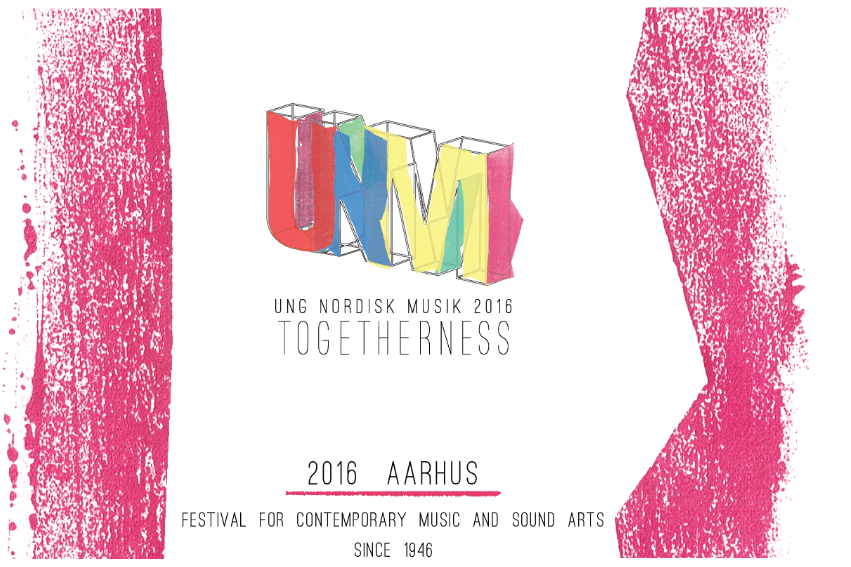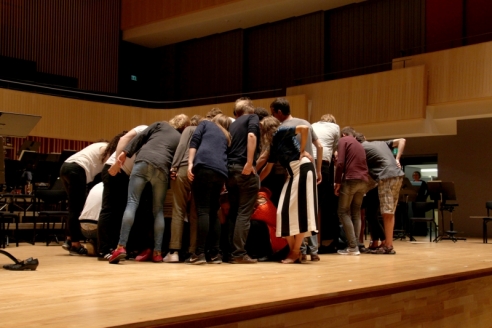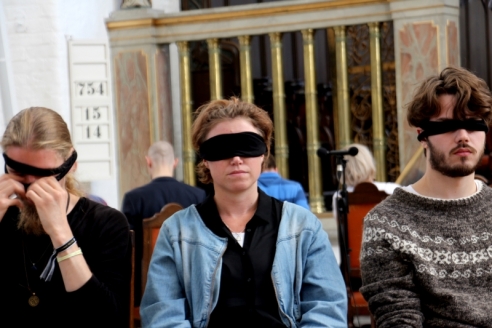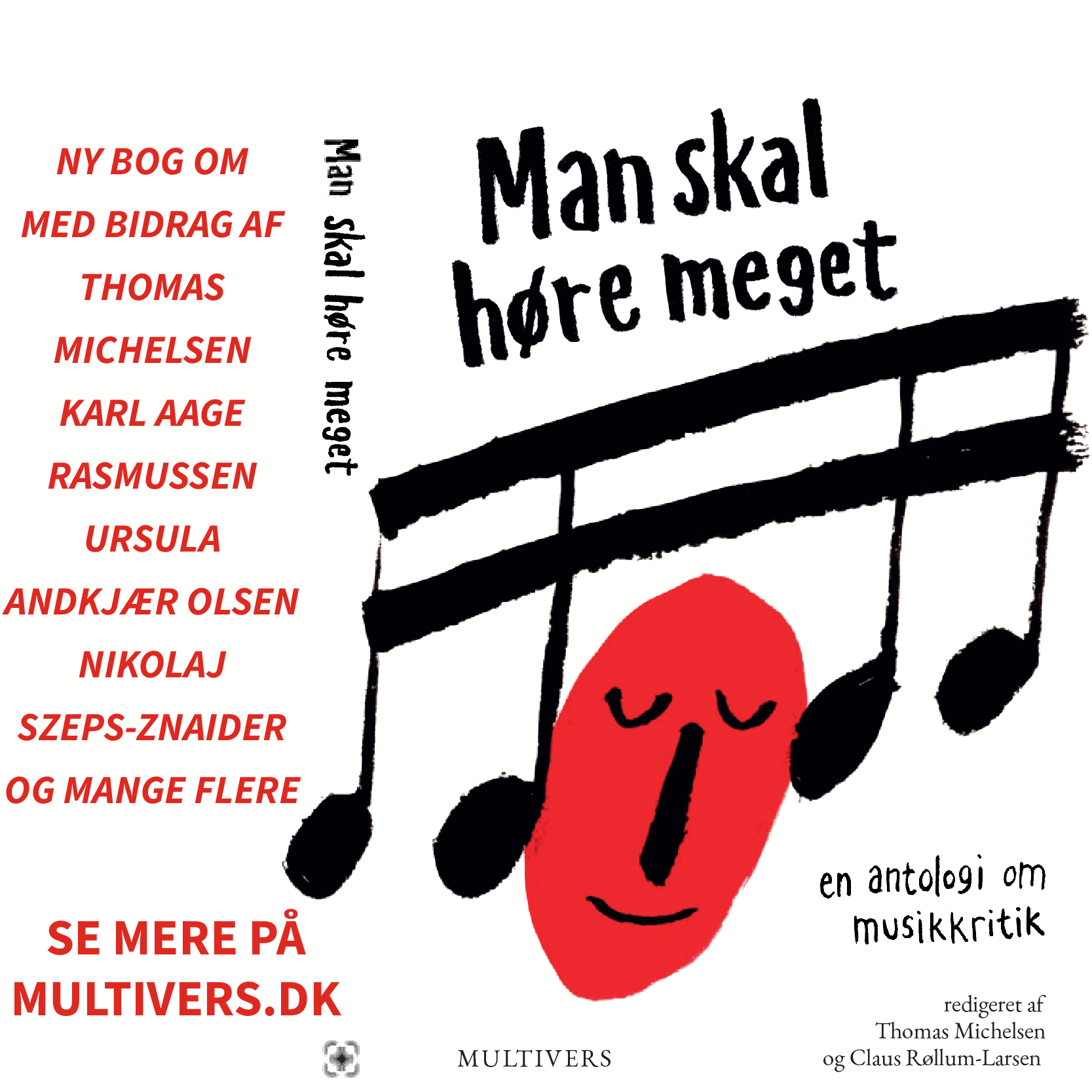
A promising week with young composers
Young Nordic Music Days, Ung Nordisk Musik (UNM), was founded in 1946 by students at the music conservatories in the Scandinavian capitals. Establishing the festival was, initially, part of a protest movement aimed at outdated institutions and educational systems, and at the same time a wish to improve contacts with colleagues in the neighbouring countries, but the Young Nordic Music Days have long since received a high status as an event in its own right, which basically has no parallel in the rest of the world. The opportunity for young composers, 30 years or younger, to take some of their first steps in the uncertain terrain of contemporary music together with people in the same stage in the professional world and with similar experiences – although from different cities within the Nordic countries – has proven to be of tremendous importance for personal development as well as for establishing contacts and further exchanges within Scandinavia.
This year, UNM celebrated its 70th anniversary in Aarhus, Denmark, with the theme of “Togetherness” – more a sign of appreciation and celebration of the fact than something with a conceptual rigour, it should be said. Although partially coincidentally – the festival took place in Denmark because of the rotational system within the five Nordic countries, which made 2016 the Danish year – the city of Aarhus is indeed a good choice as hosting city. Since 1966, it has been the home of a very important organization for young composers, Aarhus Unge Tonekunstnere (AUT), which has played an important role in making Aarhus an attractive city for contemporary music, and a place where young composers, also from outside of Scandinavia, are pursuing composition studies. AUT board member Allan Gravgaard Madsen is also the chairman of the Danish delegation of UNM, and as such – along with his board members – the main responsible for this festival.
Young Nordic Music Days 2016 took place during almost one full week (Monday to Saturday), although with a relatively sparse program with one to two concerts per day, plus occasional seminars and presentations. Simon Steen-Andersen, one of this year's two guest composers (the other one being Rasmus Zwicki), gave an interesting presentation about the relationship of sound and vision in his works, and also performed his Run Time Error (2009/16) at one of the concerts.
Flashbacks and humour
The festival sparked off with not an opening concert, but "Concert #0". As a celebration of the festival’s first 70 years, this concert was devoted to older works once performed at the UNM festivals, one piece from each of the five Nordic countries. This was an interesting choice since it cast some light on the different tendencies and aesthetical directions within post-war Scandinavian music. Axel Borup-Jørgensen’s Lille Serenade for string quartet, premiered at UNM in Oslo in 1948, with its clean lines and relative ‘Sachlichkeit’, as well as the 70s pieces by Magne Hegdal, Sonata (1975) for the unusual setting of string trio, piano and oboe, and Hjálmar H. Ragnarsson, In Black and White (1978) for flute solo, all displayed the kind of very moderate modernism so typical of their time. To this, although with more of a personal statement, could be added Madeleine Isaksson’s Tång (1983) for ensemble, in which bassoon, bass clarinet, harp and cembalo presented a slowly moving passacaglia like a distorted landscape.
In the last few decades, the musical culture has contained such diversity and plurality that it's very difficult to find a general aesthetical tendency within Nordic contemporary music.
From a contemporary historical perspective, Juliana Hodkinson’s Some Reasons for Hesitating (1999) was a good choice. The sonic investigation of the different playing techniques and small sounds certainly displays an interest in Sciarrino’s music, which although has taken the shape of a very personal work. But what this transition from the 40s to the 00s shows is how a ‘random’ older work could serve as an ‘example’ of a style or general tendency, whereas in the last few decades, the musical culture has contained such diversity and plurality that it's very difficult to find a general aesthetical tendency within Nordic contemporary music. The last piece of the concert, Lauri Supponen’s fix for sinfonietta, which was not a historical work but chosen for this festival, was maybe the exception that confirms the above stated. The 15 minutes long piece was an exploration in several episodes where sonorism was juxtaposed with rhythmic as well as melodic developments. The extraordinary control of the orchestral timbres and the holding together of the developmental diversity showed a kind of skilled virtuosity that one often hears among young composers from Finland.
But not only from Finland. The official opening concert two days later on Wednesday sparked off with Ricardo S. Eizirik’s Junkyard Piece Ia, in which he, with visually witty objects, like paper rolls as bows, created a rhythmically playful deconstruction of instrumental sounds. Also a deconstruction of a sort was Allan Gravgaard Madsen’s Tanz Suite, in which three dances from three époques (classical minuet, ragtime and brostep (an LA version of dubstep)) showed another example of the combination of delicate handling of sound and humour. Likewise, Nikoloz Pasuri in Blooooooom showed skill in instrumentation. If Eizirik can be placed in the line of a Lachenmann deconstruction of sounds, Pasuri displayed more of a French sensualism with layers of reverberating masses. An indeed personal approach was Halldór Smárson’s it means what you think it means. A small fragmentary line accompanied a TV show from the 70s featuring Anthony Burgess, mostly quiet, but occasionally with sound. The juxtaposition was as abstract as it seemed randomly chosen, but somehow managed to be just very right with both an emotional synthesis and comical effects. As further contrast the concert also presented the minimalist piece Landet som icke är for two sopranos, cello and vibraphone by Elvin Matz.
 Rehearsal of Rasmus Zwicki's piece for two pianos. Copyright: Swami Silva / UNM
Rehearsal of Rasmus Zwicki's piece for two pianos. Copyright: Swami Silva / UNM
A great diversity
At the following electroacoustic concert a nice selection of different works was presented. From a classical ‘tape’ piece by Harald Jordal Johannessen, via Fjóla Evans' Augun, where the composer herself presents melodic lines on her cello in interaction with the lush pre-recorded harmonies, to Kajsa Magnarsson's Improvisation for Rape Alarm Organ, a piece with obvious political implications, although the title also suggests that this is also a specially constructed musical instrument, which Magnarsson manoeuvred in an intensive performance. After the intermission, Olle Petersson and Olle Sundström gave, with Omringad, an impressive performance of what could be seen as a contemporary reincarnation of the classical text-sound genre, with live voice which was likewise live-processed into a collage, partially resembling the sound world of the text-sound compositions from the 70s and 80s. Loïc Destremau's Faulty Waterwork, executed by Heigo Rosin, was a beautiful play with miked water, lit candles and a small tape recorder dipped into the water – a reference to Händel’s Water Music as well as John Cage’s classical Water Walk. Rounding up a concert that gave good proof of variety as well as mastering of means among young composers, Bergrún Snæbjörnsdóttir together with Ingibjörg Fri∂riksdóttir used a self-constructed instrument in the audiovisual The Cancerous Cell.
In general, the UNM concerts were very well curated with a nice and interesting mix of works and styles that reflected a variety within a special discipline or format.
In general, the UNM concerts were very well curated with a nice and interesting mix of works and styles that reflected a variety within a special discipline or format. Another example of this was the chamber music concert on Thursday evening. Here one could hear Haukur þór Har∂arson’s string quartet Through the whole fabric of my being with its delicate use of flageolets, next to James Black’s wind quintet At night, walking shoes full of blood on the door (or, steam heating a room full of opium) and the juxtaposition of fast and high-pitched hustles and irregular noises. This was followed by a sharp turn in the form of Saara Lindahl’s almost new-romantic piano quintet Between.Time.and.Infinity. In Jonas Skaarud’s SHAPES, BOOK I, the emphasis was on the dialogue with the sparse and short sounds of the accordion and flute, and almost logically followed Aya Yoshida’s string quartet Polka Dots, which presented an entertaining row of small episodes of small sounds.
Also for the following late concert in the Aarhus Dome, the organizers had managed to find a fine selection of fitting works. But after Lo Kristenson’s indeed tension-rising klangkropp :: motstånd for viola and key harp, with its long tones and hard rubbing, which had been preceded by the ensemble piece Fold by Finnur Karlsson with its reference to baroque music, which also sounded excellent in this space, almost one hour had already passed, and with half of the program to go, this was maybe the only concert which might have been a bit too ambitious for its own best. Árni Bergur Zoëga’s Katabasis II for ensemble was however a dramatically intense piece, as was Yarn by Madeleine Jonsson Gille with two violins gradually ravelling in intensive noises. The concert closed with Martin Andreas Hirsti-Kvam’s Sparks, a sedate work for choir and organ with subtly balanced pauses and light.
Mickey mousing
The following day, Klara Andersson’s work Efter Stormen was performed three times for a limited number of people at the time. Blindfolded, sitting on chairs in a circle, the listeners were exposed to three voices that dealt conceptually with abuse. Among the interesting aspects was the spatial distribution of the singers which initially evoked the perception of a pre-recorded multi-channel work. As the work gradually evolved, this turned into a likewise acousmatic sound work with the singers moving around the listeners. A work perfectly casted for the cathedral.
The works at the Sound and Vision concert in the evening all exposed similar ambitions in linking electronic or acoustic sound with digital images or film.
The works at the Sound and Vision concert in the evening all exposed similar ambitions in linking electronic or acoustic sound with digital images or film. The approaches to the subject matter as well as to the form differed, however. The animation in Jonas Ulrik Eide’s It emits light to help friends was theoretically (involving text) and visually about colours, with the musicians playing along in an ‘improv’ style. The duo Destroyer (Tatu Nenonen and Ilmari Karhu) performed a 45 minutes long audiovisual piece in the classical dark noise and abstract visuals genre. Meanwhile, Saara Viika / Ilona Raivio / Ilkka Hautala presented the most personal concept with short visual portraits of different people, shot in the days leading up to the concert, edited and presented with a poem written during the photo session in real-time. The films were then interpreted by three improvising musicians. The concert was framed by two sets of Simon Steen-Andersen’s Run Time Error, which is a perfect example, maybe even a masterpiece, of the different ways to work with the audiovisual technique of so-called ‘mickey mousing’.
Saturday, the last day of the festival, started with the short opera River's Edge by Tan Tuan Hao, in which the composer showed an excellent handling of the vocal line as well as building up the atmosphere through a tentative texture in the chamber ensemble. The closing orchestral concert on Saturday opened with a piece for solo tuba by Niilo Tarnanen – a kind of fanfare for the week that had passed and the works that would follow. Two equally nicely built short orchestral works by Steiner Yggeseth and Christos Ntovas, respectively, both unfolded in lush orchestral sonic weaves. As a contrast, Dominique Lafortune’s Re-Tailles followed, which was rhythmically advanced, occasionally tumultuous in the best sense, and with a virtuous handling of the orchestral resources. Like Yggeseth and Ntovas, Sebastian Hilli also worked with sonic layers, although with a bit more of expressionistic force. As yet another contrast Cecilia Damström’s Unborn op. 31 followed with a suggestive, almost ritual pounding in the percussion, drone-like strings and erupting wind. The concert closed with a piece for two pianos (2002) by Rasmus Zwicki, around which about 50 people were clustered, hammering the keys and one by one leaving the stage – saying goodbye for now while also referring to the festival theme of “Togetherness”.
 Klara Andersson's 'Efter Stormen'. Copyright: Swami Silva / UNM
Klara Andersson's 'Efter Stormen'. Copyright: Swami Silva / UNM
More than notated music
There is no doubt that UNM plays an important role in the formation of composers as well as networks even today. The fact that a not too small amount of the composers presented at the festival were either exchange students or had chosen to study in the Scandinavian countries also broadened the perspective as well as presumed future connections to countries like Canada, Brazil, Germany, Singapore, Greece, Georgia, Japan and the UK. One could however ask from the experience of this week how good UNM actually is at reaching out to the broader definition of contemporary music; something which festivals as well as higher education with their different sound art programs are devoted to. As a matter of fact, the only work that could be called ‘sound art’ was the very fine concert installation Í ∂rum/Underground by Ingibjörg Fridriksdóttir which was presented as a ‘Nachspiel’ to the chamber concert on Thursday. Here data sampled from seismic activity triggered self-built keys which hit the strings and interior of a piano.
Obviously, there is nothing wrong with notated concert music, but the contemporary musical field is broader than that.
But this was an exception and as such a clear indication that UNM is mainly a festival for composed and notated music performed in concert settings. This is something that the UNM organizations in the different countries are aware of, and for the festival in Malmö in 2014, for example, initiative was taken in order to try and reach out for submissions also from other fields of art. Obviously, there is nothing wrong with notated concert music, but the contemporary musical field is broader than that. And since, sadly but true, the contemporary music field shows more interest in the other art forms than the other way around, and since the new music always has to do more for less – work with less money, getting less media attention – in order not to risk art music’s further cultural isolation, there are certainly arguments enough for trying harder.
One could remark that there were not many deviations from the general styles and form regarding the orchestral works. Or that some of the more small-scale pieces that actually tried to experiment with the artistic expressions and concepts not always managed to find a convincing artistic form. On the other hand, one important thing with this festival is to provide aspiring composers with an orchestra, and one certainly can’t expect fully mature and personal works at one of the first attempts. The same goes for the experiments; that’s also what the festival is there for. In general, the UNM festival in Aarhus showed proof of very high standards of composition as well as musicianship.
The future of UNM
The latter is a fact that actually has both advantages and possible disadvantages. UNM was once instigated for the young composers; later on the festival became more important also for the young musicians, but is today mainly a young composers’ forum with the opportunity for high-class performances. But new music needs their musicians too. The tendency to hire also professional musicians should maybe not be completely abandoned, but taken into consideration, starting from the fundamental question of how the young contemporary musical scene can benefit and thrive from UNM in the best way. This is important also from the point of view of the expanded musical field, which has partially changed or expanded the role of the musician to be a more active agent, if not a composer; the musician is becoming more of an auteur, an artist/curator in his or her own right. Actively working for the artistically driven musicians, involving musicians as more than ‘only’ interpreters is a major future task for the UNM.
UNM is indeed important for the scene, but the scene, including the local scene, needs to find its audience and mark its place – because it has a place! – within the cultural landscape.
A similar remark can be made with regards to what cities the festival takes place in. There has been a clear tendency in the last decades to arrange the festival in the main Scandinavian cities, larger cities with a music conservatory. In terms of concentration of resources, this is of course a good idea, but a living culture is something that finds its coordinates around a vast geographical and cultural field, in small cities as well as in metropoles. During the 70s, UNM took place also in smaller cities, and for the possibility of obtaining regional funding and the prospect of making a mark and actually getting some local attention with the festival, this is also something to consider. UNM is indeed important for the scene, but the scene, including the local scene, needs to find its audience and mark its place – because it has a place! – within the cultural landscape.
